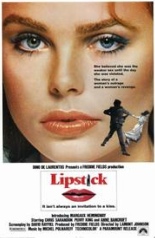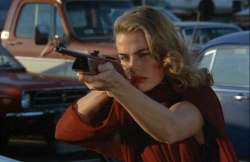
 How can you tell Lipstick was made in the ’70s? Two out of the three credited experts are male. Back then, you could make a movie about rape and still barely consider the female point of view. This probably explains why it’s best remembered today as a lurid melodrama, and not the call to social action some of those involved clearly wanted it to be.
How can you tell Lipstick was made in the ’70s? Two out of the three credited experts are male. Back then, you could make a movie about rape and still barely consider the female point of view. This probably explains why it’s best remembered today as a lurid melodrama, and not the call to social action some of those involved clearly wanted it to be.
In the film, Margaux Hemingway plays a model whose life is torn apart when she is raped by a psychotic music teacher (Chris Sarandon). When the jury buys his lawyer’s argument that she was asking for it by having a vagina, she is suddenly unemployable and ready to leave town after her last photo shoot.
 Tragically, however, Sarandon is in the same building as the shoot and decides to attack Margaux’s adolescent sister (her real-life sibling, Mariel). Knowing the law isn’t on her side, Margaux decides to grab a shotgun and ensure Sarandon never hurts anyone else ever again (by shooting him in the balls).
Tragically, however, Sarandon is in the same building as the shoot and decides to attack Margaux’s adolescent sister (her real-life sibling, Mariel). Knowing the law isn’t on her side, Margaux decides to grab a shotgun and ensure Sarandon never hurts anyone else ever again (by shooting him in the balls).
Lipstick ends with the jury exonerating Margaux via an obviously last-minute voiceover. Apparently, the irony that she might go to prison after her attacker was freed was too much for audiences to take, and the producers decided to go with a happier ending. This irony might have gone a long way toward justifying the film’s long middle stretch of interminable courtroom scenes, but we’ll never know. Instead, the end result is a mostly terrible movie with a handful of effectively gripping scenes that can only be recommended to die-hard fans of the rape-revenge genre. —Allan Mott
